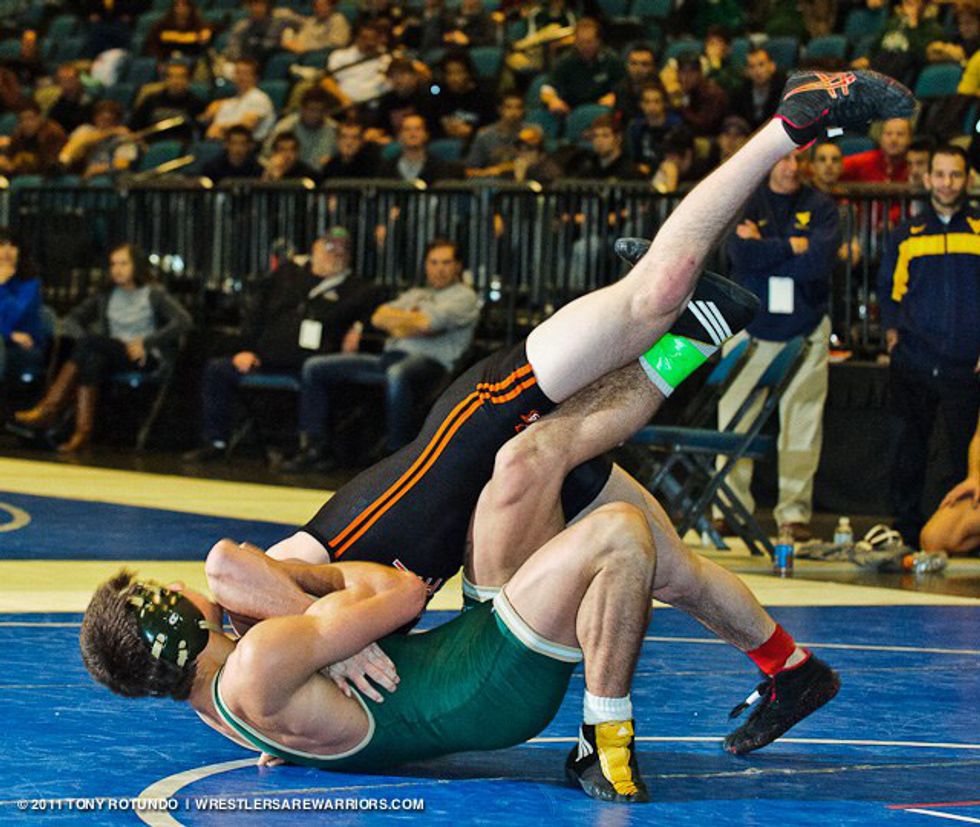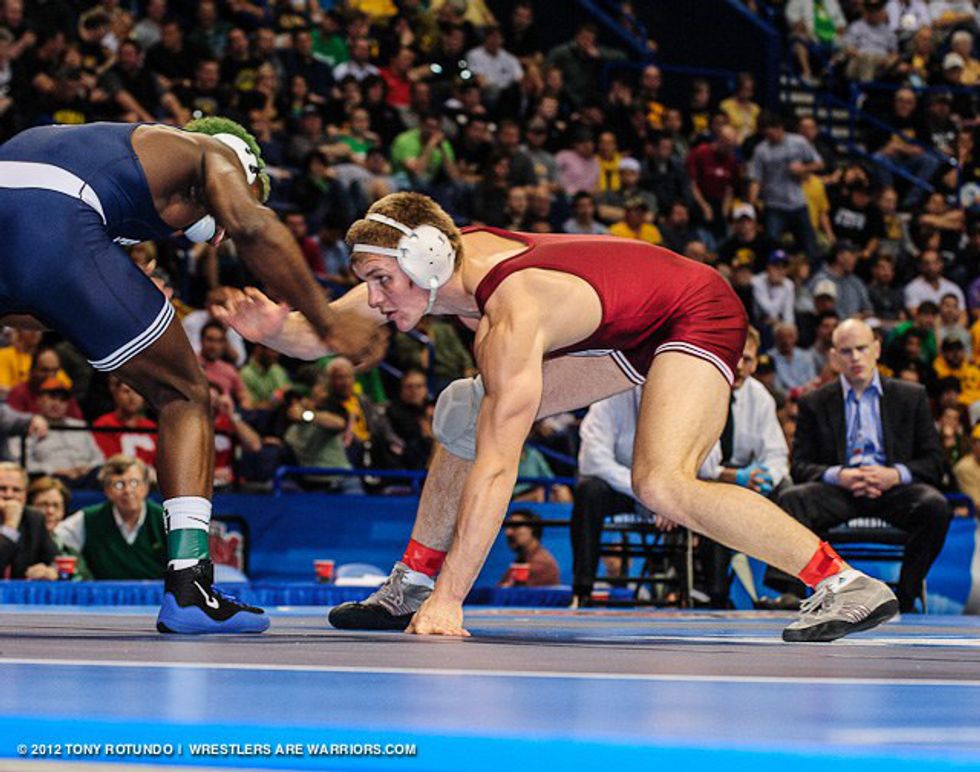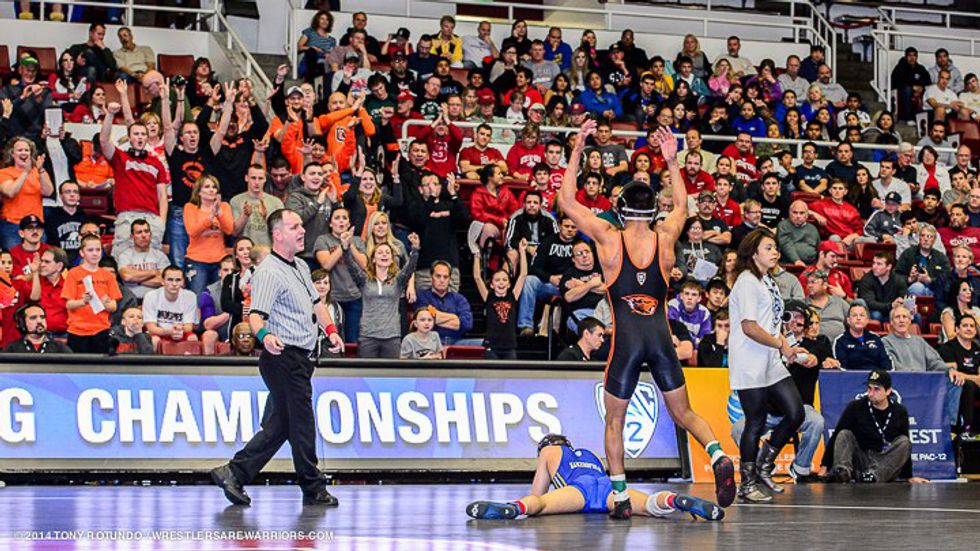Coach Jason Borrelli (Class of ‘06), entering his 9th-year at the helm of Stanford, and Coach Mike Mendoza (Class of ‘99), entering his 7th-year as the Head Coach of CSU Bakersfield, will soon find themselves considered the veteran-coaches of the Pac-12 Conference—in addition to, of course, the 6x Pac-12 Coach of the Year, Jim Zalesky of Oregon State, and the former Head Coach of the US Men’s Freestyle National Team, Zeke Jones of Arizona State—as 3 programs in the Pac-12 (Cal Poly, Boise St., and eventually Fresno State) will have new head coaches going forward.
Changing of the Guard
In 2014, Zeke Jones took the reins at his alma mater of Arizona State. His entrance into the Pac-12 marked the start of changes in-conference. In the past year or so, Fresno State (who presumably will join the Pac-12 conference) announced the reinstatement of its wrestling program, which was dropped in 2006, and that the hunt was on for a new coach. Cal Poly’s Head Coach Brendan Buckley resigned in March, taking a position with Beat The Streets, and now, Boise State has opened up its Head Coaching position after a few years’ slide in performance.
A Conference Among Others
The NCAA D1 wrestling landscape has been in a lot of flux recently on the intra- and inter-conference levels. While the 14-team B1G (Big Ten) remains the “SEC of College Wrestling”, the ACC, MAC, EIWA and post-merger BIGXII (Big 12) have developed strong, national-power programs that rival the top B1G schools in recent years (Cornell, University of Missouri, NC State, Virginia Tech are a few examples). The BIGXII recently merged with the now defunct Western Wrestling Conference (WWC) to grow the conference to a 10-team race. The 6-team ACC has developed into a serious conference, along with the developing 9-team MAC and the ancient EIWA (Eastern Intercollegiate Wrestling Association, 16 teams). In all this development across the D1 landscape, the Pac-12 seems to (finally) be shaking up for the better. Hopefully, these coaching changes reflect a trend amongst Pac-12 coaches that is already being seen in ACC coaches, i.e., the steady, workmanlike development of programs that had failed to produce steady results (e.g., NC State (ACC) under Pat Popolizio).
The Pac-12 had promising NCAA showings leading into the 2010’s, which had made me optimistic in the first-half of the decade. However, the last couple years have been stagnant in terms of conference strength. In 2010, the Pac-12 was 4th behind the B1G, EIWA, and BIGXII in automatic qualifiers to the NCAAs. In 2016, the conference slid to 6th behind the B1G, EIWA, MAC, BIGXII, and the surging ACC, with the Pac-12 share of total number of qualifiers shrinking as well (33 vs 21).
2010 NCAA Qualifier Allocations
2016 NCAA Qualifier Allocations
Pac-12 Performance at the NCAA Championships
2010 | 2011 | 2012 | 2013 | 2014 | 2015 | 2016 | |
Top Team Place | 11th | 6th | 10th | 8th | 25th | 29th | 19th |
Total All- Americans | 7 | 11 | 7 | 4 | 2 | 2 | 4 |
Total Top-12s | 4 | 1 | 1 | 5 | 6 | 4 | 4 |
(If a team’s placing is omitted, it is because they failed to score team points.)
(Boris Novachkov, Cal Poly-SLO, NCAA-Runner up (bottom) attempts to launch conference rival Michael Mangrum, Oregon State, NCAA All-American)
In 2010, the Pac-12 was led at NCAAs by Boise State’s 11th place finish, followed by Cal Poly (18th), Stanford (28th), and Arizona State (30th), with a total of 7 conference All-Americans. Boise State was propelled by Adam Hall (3rd-place) and Kirk Smith (2nd). The Cal Poly-SLO Mustangs also had two AAs, with Boris Novachkov (7th) and Chase Pami (2nd) leading the charge. Stanford was powered by Nick Amuchastegui’s 4th-place finish while Arizona State’s Anthony Robles (7th) and CSU-Bakersfield’s Mitch Monteiro (5th) also picked-up individual AAs.
(Anthony Robles, Arizona State, NCAA Champion)
The following year, 2011, the conference turned in one of its best overall performance in recent memory, as Arizona State (6th) and Boise State (9th) broke into the top-10 at NCAAs, with Stanford just outside at 11th. Oregon State finished 21st, while Cal Poly came in 32nd place.
The Sun Devils contributed 2 national titles (Anthony Robles and Bubba Jenkins) to the total 11 conference All-Americans, as ASU nabbed 3 total AAs. The Broncos of Boise State were in hot pursuit with 3 AAs of their own in Andrew Hochstrasser, Jason Chamberlain, and Adam Hall (2nd, 3rd, 5th respectively). The Cardinal also earned 3 AAs with Ryan Mango, Nick Amuchastegui, Zack Giesen (6th, 2nd, 6th) punching into the top-8. Oregon State had one All-American in Colby Covington (5th), leaving Michael Mangrum in the top-12 round. Cal Poly’s lone AA was Boris Novachkov, who reached the NCAA finals.
(Nick Amuchastegui, Stanford University, NCAA Runner-up)
In 2012, Oregon State led the conference with a 10th place finish, followed by Stanford (16th), and Cal Poly rounding out the top-25 in 25th. Boise State and Arizona State had meteoric falls from their 2011 performances, placing 51st and 56th, respectively. The conference (on the backs of Stanford, Cal Poly, and Oregon State) was able to tab 7 All-Americans.
The Beavers of OSU had 3 AAs in Michael Mangrum, Scott Sakaguchi, and Clayton Jack (5th, 7th, 4th). The Stanford AAs were Ryan Mango (5th) and NCAA Runner-up Nick Amuchastegui. The Mustangs had 2 AAs as well in Boris Novachkov (3rd) and Ryan DesRoches (8th).
For new fans of wrestling, the round of 12 is also known as the “blood round” in the (wrestling) community, as it determines whether a wrestler leaves the tournament with a medal or a handshake. Win in the blood round, you assure yourself a top-8 (All-American) finish-- lose in the blood round, you go home empty handed. This is where many Pac-12 wrestlers found themselves in 2013 and 2014.
(Jason Chamberlain, Boise State, NCAA Runner-up)
Oregon State continued to build in 2013, placing 8th at NCAAs. Besides Boise State (19th), the rest of the Pac-12 had poor performances. Stanford (38th), Arizona State (41st), and CSU-Bakersfield (60th) round out point-scoring teams for the conference. The All-American count dwindled to 4, and 3 of those 4 were Beavers (Scott Sakaguchi, 5th; Roger Pena, 5th; Taylor Meeks, 4th). The lone Boise State Bronco AA was Jason Chamberlain, who finished as an NCAA Runner-up.
While OSU still had the majority of the conference AAs, they had two lose in the blood round, Chad Hanke and returning-AA Michael Mangrum. Boise State had three lose in the blood round as well (George Ivanov, Jacob Swartz, JT Felix).
(Pac-12 Conference Championships, 2014)
The 2014 NCAA Championships was a dark time for the Pac-12. Boise State was the conference leader in 25th (yes, twenty-fifth) and only the CSU-Bakersfield Roadrunners and Boise St. Broncos flew home with an All-American (Bryce Hammond, 8th; Jacob Swartz, 7th), bringing the conference All-American count to 2 total. The Bronco’s J.T. Felix, who was awarded the Gorriaran Award for most pins at the NCAA tournament in the least time, again lost in the top-12 round.
Behind the Broncos by a single point was Oregon State in 28th. Returning AA Scott Sakaguchi also fell in the round of 12 disappointingly for the Beavers, while teammates (and returning AAs in their own right) Pena and Meeks failed to repeat-AA as well.
After returning from an Olympic Redshirt, 2x All-American (at 125) Ryan Mango of Stanford finished round of 12 his senior year (at 133), a win away from repeating AA-honors for a third time. Stanford would finish in 40th place.
Bryce Hammond’s AA performance was the lone driving force for CSU-Bakersfield’s 47th place finish, while Arizona State (58th) had Blake Stauffer finish Top-12 after making it to the quarter-finals. Cal Poly-SLO was 63rd.
(Blake Stauffer, Arizona State, NCAA All-American)
Following the complete drop-off that was 2014, Blake Stauffer got the Sun Devils back on track with a 4th-place/ AA performance in 2015, propelling ASU to 29th, making the Sun Devils the conference leader at NCAAs (keep in mind, this was Zeke Jones’s first year as head coach). While the Pac-12 may have continued to slip, the range of Pac-12 teams tightened. Oregon State was 1pt behind ASU in 30th, with Stanford (35th), Boise State (43rd), Cal Poly and CSU-Bakersfield (T58th) trailing.
Stanford’s Jim Wilson led the Cardinal, earning AA-honors placing 8th. Oregon State, unfortunately, had three wrestlers lose in the round of 12, including AA Taylor Meeks. Boise State’s Geo Martinez would come up short in his bid to All-American in the round of 12 as well. The conference AA total in 2015 would be 2 for the second straight year.
(Connor Schram, Stanford University, NCAA All-American)
This year, 2016, Stanford returned the Pac-12 to the top-20, finishing 19th, with Oregon State right behind at 22nd. ASU and CSU-Bakersfield followed in 36th, whilst Boise State rounded out the Pac-12 at 43rd. Cal Poly had 0 NCAA qualifiers.
Stanford was driven by two AAs in Connor Schram and Joey McKenna (8th, 3rd respectively), though returning AA Jim Wilson ended his tournament top-12. Oregon State gained another heavyweight AA with Amarveer Dhesi (5th), while veteran Ronnie Bresser fell in the top 12. Finally getting back into the mix was the Roadrunners of Bakersfield, who qualified half their team (5) for the tournament, though none AA’d (including All-American Bryce Hammond). The Sun Devils matched Bakersfield with 5 qualifiers of their own. Returning AA Blake Stauffer and Tanner Hall both finished top-12 for ASU. Geo Martinez wrote the right act (after 2015’s blood round disappointment) and earned his All-American honors for the Broncos.
Renaissance, anybody?
In my eyes, the only way is up for the Pac-12. Borrelli of Stanford and Zalesky of Oregon State (a 3x National Championship coach during his tenure at the University of Iowa) have proven that they can produce individual All-Americans on a pretty consistent basis. What I'm waiting for is solid teams to come out of the Cardinal and Beavers. Further, Coach Mendoza and staff at CSU-Bakersfield have made a believer out of me after the 2015-2016 performance. Though the five qualifiers for the Roadrunners failed to perform in the way they had all season, I believe the future is bright in Bakersfield.
As for the newer coaches, Zeke Jones is one of the most overqualified coaches in the field, particular in light of his experience leading the World/ Olympic Team(s). The transition for Arizona State from a mid-rate team back to prominence will likely come sooner rather than later, as Jones had no intention of rushing the new-crop of Sun Devil-recruits that flocked after his hire. We'll see in the 2016-2017 how loaded Zeke Jones's team is as the redshirts come off for many freshman. At Cal Poly, Jon Sioredas was hired recently after Grand Canyon University (which was slated to join the Pac-12 and become the newest D1 wrestling program) dropped wrestling as a varsity sport. Sioredas had a short but promising two-year tenure as GCU’s head coach. We’ll see if he can revitalize the limping Mustangs moving forward.
As for the up-in-the-air programs, Boise State and Fresno State, Pac-12 fans will have to hold their breaths. Boise State’s Geo Martinez stands as an example that the Bronco room can still develop All-Americans. The new head coach there will need to capitalize and build upon the tradition at BSU to return it to top-10 results.
The return of Fresno State wrestling has many interesting connotations, especially for the state of California (known for its deep High School talent but, now, disparate NCAA D1 representation). Fresno is a hotbed for wrestling talent, so I do not believe recruiting will necessarily be a struggle. The blank slate will require a visionary that can use what he has (rich high school culture, tradition, and community support) to build a program that was axed a decade ago, rather than a coach that see’s the fresh-start as a detriment.
It will take a lot of effort to steer the Pac-12 as a conference by to national contention, but with the new faces joining the likes of Borrelli, Zalesky, and Mendoza, I believe the Pac-12 is just starting to heat up.
(Photos by: Tony Rotundo/WrestlersAreWarriors.com)















































